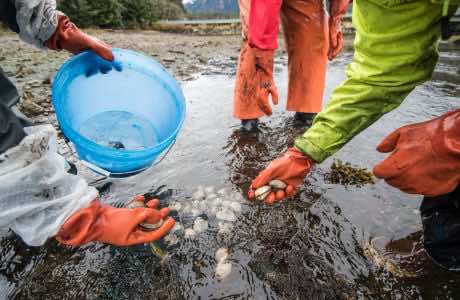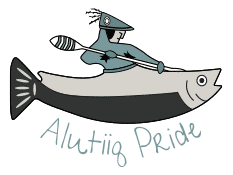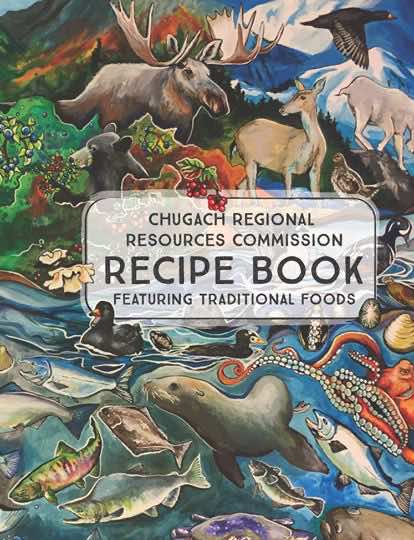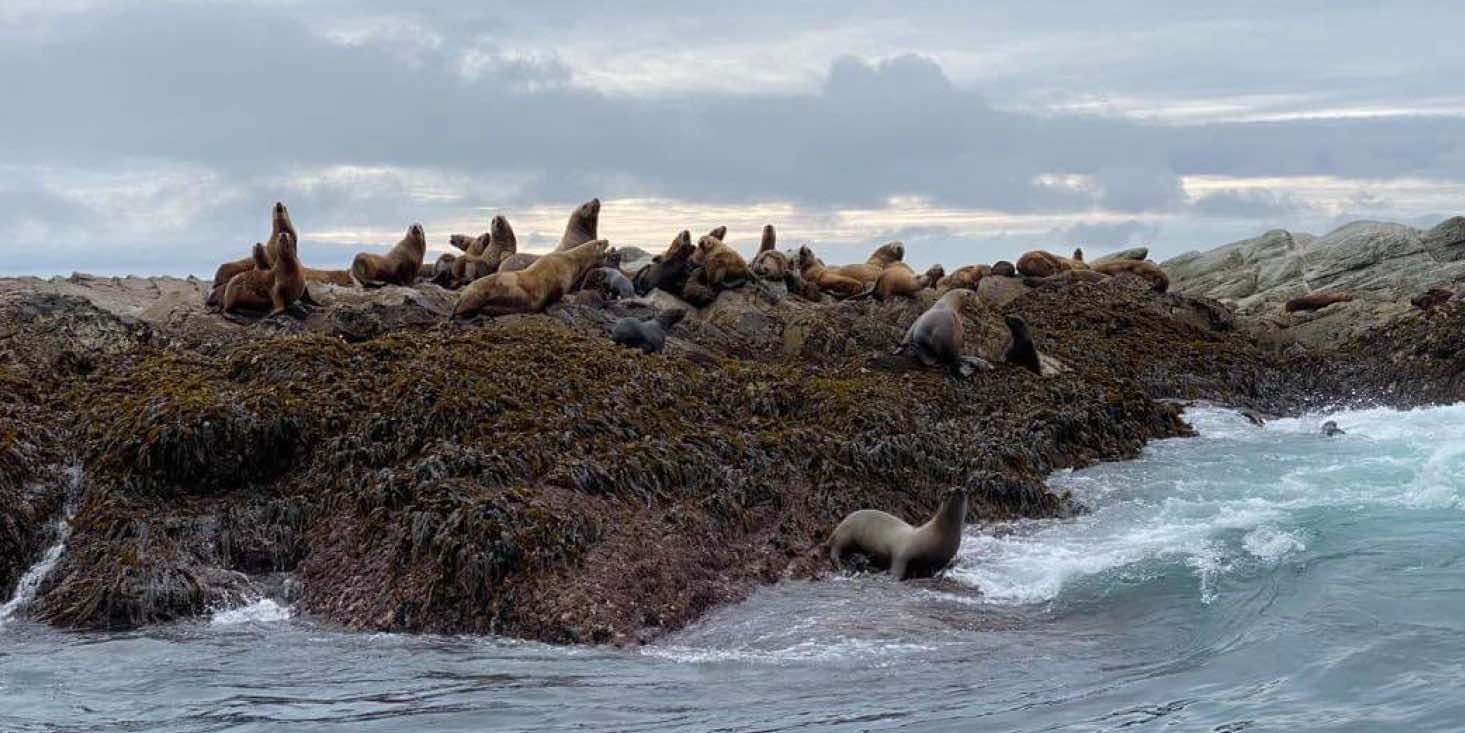CRRC 2022 Q1 Newsletter

2021 was an exciting year for Chugach Regional Resource Commission (CRRC) and Alutiiq Pride Marine Institute (APMI). We established a new monitoring program, the Chugach Regional Ocean Monitoring program, which examines ocean chemistry, harmful algae, and shellfish biotoxins. The CROM program is a combination of our preexisting Ocean Acidification Lab and our newly established Harmful Algae Bloom Lab. In early May, APMI held a training workshop for IGAP samplers and community samplers. Additionally, APMI employees traveled to communities to conduct in-person training with community members. These trainings provided the samplers with the skills and knowledge to collect weekly phytoplankton, ocean acidification, and ocean chemistry samples. The CROM lab collected data weekly from Resurrection bay and received samples from Chenega and the Forest Service in PWS. In 2022 APMI is hoping to expand our sampling range and involve all our communities. If you are interested in becoming involved in sampling and documenting how our ocean is changing, please contact Stephen Payton (). Stephen is CRRC’s IGAP coordinator and has sampled for HAB’s and OA in Seldovia for over 6 years!
The Alutiiq Pride Marine Institute was featured in Cook Inlet Aquaculture Association‘s SMOLTS Newsletter. In this article is information about our ocean acidification monitoring program at the Alutiiq Pride Marine Institute in Seward, Alaska. The full SMOLTS newsletter can be read by clicking here.
Christine Brummer joined the CRRC team at the end of October 2021 as the Fish and Wildlife Coordinator. Her job focuses on regulatory advocacy for CRRC’s seven tribes to the Board of Fish, Board of Game, Federal Subsistence Board, Southcentral Regional Advisory Council, and North Pacific Fishery Management Council. The mission is to protect Alaska Native hunting and fishing rights and ensure traditional land and resource management. Christine meets with local officials, State and Federal professionals, and other parties in order to establish working relationships that serves our tribes best interests, works with the CRRC inter-tribal liaison to complete project goals, and assists the CRRC team in Alliance capacity building.

Subsistence Resource Management Program
CRRC staff recently attended the Board of Fish (BOF) meeting in Cordova, from November 30-December 06, 2021. One staff member provided oral testimony to support Chenega proposals 26 and 27, and the Native Village of Eyak proposals 28 and 29. The BOF decisions on the proposals are as follows: opposed 26, no action on 27, supported 28, and opposed 29. These proposals and informational about the BOF meeting can be found at:
https://www.adfg.alaska.gov/index.cfm?adfg=fisheriesboard.meetinginfo&date=11-30-2021&meeting=cordova
Recording of the entire meeting can be found at:
https://www.adfg.alaska.gov/static/regulations/regprocess/fisheriesboard/swf/2021-2022/pws21/index.html
Upcoming Regulatory Dates/Meetings:
- The Board of Game will have a call for proposals, relating to the Southcentral Region (GMUs 6, 7, 8, 14C, & 15), in January 2022 with the proposal deadline of May 01, 2022.
- The Federal Subsistence Board has a Work Session on January 30, 2022.
- The Southcentral Regional Advisor Council will meet in Anchorage on February 10-11, 2022.
- The Board of Game will meet in Fairbanks on March 4-11, 2022.
- The Board of Fish will meet in Anchorage on March 11-16, 2022.
- The Federal Subsistence Board’s Wildlife Regulatory Meeting will take place April 12-15, 2022.
For more meeting dates and information or if you have any questions/concerns you can contact Christine Brummer at .
Do you use subsistence foods? Have you noticed changes in the plants and animals that you hunt, fish, and gather? How concerned are you about these changes? How will changes to subsistence foods affect you and your family?
These are all questions CRRC has been asking as part of our Climate Change Vulnerability Assessment, both in community meetings held before the pandemic started in Chenega, Port Graham, and Seward, as well as though an online survey. The graph above shows the results of all the answers for all our communities combined.
The lower axis represents risk to the resource. We asked community members if they thought climate change poses a low, medium, or high risk to each resource. As you look from left to right across the graph, the species on the left are considered more resilient to climate impacts, and the species towards the right more vulnerable to climate impacts.
The vertical axis represents how much of an impact changes to that resource would have on community members. We asked: “On a scale of 1 to 10, with 1 being no noticeable impact and 10 being a life-changing impact like moving to a new town or taking a new job, how much would changes to the availability of this resource impact you and your family?” Species that are not as commonly utilized in the region tend to be towards the bottom of the graph, whereas species that are most important culturally, economically, and for food are towards the top of the graph. If we split the graph into quadrants, we can get a rough idea of how “vulnerable” the region is to changes in the abundance, timing, or distribution of these species.
|
Highly utilized resource, and lower risk of being negatively impacted by climate change |
Highly utilized resource, and high risk of being negatively impacted by climate change |
|
Less utilized resource, and lower risk of being impacted negatively by climate change
|
Less utilized resource, and high risk of being negatively impacted by climate change |
There is one exception to this matrix. Invasive species are very high on the risk scale and the impact scale because people expressed great concern about the ecological risks they pose to other species, not the risk to those invasive species themselves. People expressed concern about fleas and ticks moving into the area and spreading new diseases to important wildlife. Spruce bark beetles were a big concern because dead spruce burns easily, and severe infestations can lead to prime conditions for forest fires. And, well, as anyone who has lived in a community infested with black slugs can attest, those are just plain gross, plus they can locally exterminate favored plants if their numbers are high enough. Similarly, jellyfish scored very high on the risk scale not out of concern for jellyfish, but because people noted an overabundance of them and wondered what that means for the rest of the ocean’s health.
Looking at the graph, it’s easy to see why we say “when the tide’s out, the table’s set.” Ocean species make up the majority of the species in the highly utilized, high risk category. The ocean is always changing, but now it seems to be changing in new ways. Ocean acidification weakens shellfish shells, reducing survival. Warming ocean temperatures may be responsible for seabird die offs. Salmon recruitment is much less than it has been historically, and researchers believe something in the oceans is likely behind it. As glaciers retreat away from the oceans, seal habitat is diminished and they are easier prey for ocean predators. The ocean is always dynamic, always changing, and so resilience is built into the life histories of many marine species, but is there a tipping point where ecosystems will change dramatically, and if so, what is that tipping point? This is a question we may not be able to answer, but through this work we will better understand and be able to develop plans to respond to changes in the environment and subsistence resources.
Land animals and plants are perceived as being less at risk, though people also expressed concerns about the future of terrestrial ecosystems. Seasonal drought in summer was a major concern among people we spoke with, especially as glaciers recede further and may no longer contribute the same runoff to streams and rivers. This can affect salmon runs, which may also affect land species that depend on those salmon, both directly like bears and indirectly like moose, who rely on the plants that rely on the nutrients that salmon bring upriver when they spawn. Additionally, changing climate has made it more difficult for people to harvest some of the animals they need, with hunting seasons no longer matching when animals are moving around, and animals with changing migration patterns that make them harder to get to.
Do you agree or disagree with the graph of current responses? Are there any species we’re missing? Have you observed changes in your environment and in the wild foods you eat that you would be willing to share with us? As we move towards wrapping up the vulnerability assessment and entering the adaptation planning phase, we want to hear more about how climate change is and may impact you and your family, and what you think we, as a region, can do to . Please consider sharing your experience and observations with us in an interview. See our flyer below for more information on how to do this.

Traditional Foods Recipes
Chugach Regional Resources Commission produced a recipe book based on recipes from Tribal members in the Chugach region.
The recipe book can be purchased here: https://chugach-regional-resources-commission.square.site/product/recipe-book-featuring-traditional-foods/3?cp=true&sa=true&sbp=false&q=false
In an effort to enhance food security in the region, CRRC used CDC grants funds to remaster the recipe pages to include nutritional values provided by the ANTHC as well as translations in various dialects, when available, from the Chugachmiut Heritage Preservation.
Check out a recent blog – – When The Tide is Out, The Table is Set – – published by the Ocean Conservancy.
This blog was written by Stephen Payton, CRRC’s Regional Indian General Assistance Program Environmental Coordinator and SVT’s Environmental Assistant. He has been collecting dissolved inorganic carbon samples from our coastal waters since 2015. He is a lifelong resident of Seldovia and works to protect the subsistence resources used in the region for generations.
An article in the Scientific American January 2022 issue, titled “Protecting Alaska’s Harvest,” featured Harmful Algal Bloom research with partners in southcentral Alaska including the Alutiiq Pride Marine Institute.
Many Indigenous clammers have long avoided harvesting in summer’s warmer waters, when harmful algal blooms (HABs) are more likely to occur, potentially creating toxins that get ingested by and accumulate in local fish and shellfish. Harmful algal blooms are occurring more frequently in Alaska’s northern coastal regions, across more months of the year, making harvesting at any time a risk.
In 2021 the Alutiiq Pride Marine Institute in Seward, which represents seven Indigenous tribes, bought its own ELISA machine to start an ambitious testing program for PSP and ASP. Eventually, staff will test both water and clam flesh for toxins on a weekly basis, creating the largest, most geographically widespread monitoring in the state. Our staff has also built a data-collection portal on the institute’s Web site, where people in communities around the state can submit sampling data via a simple online form.
In November APMI staff were able to travel to Chenega to spend time with community members and monitor kelp test farms in the area.
Here is a summary of the trip from Chenega’s Village Environmental and IGAP Coordinator – Carmen Butler
On November 30th I had the privilege of accompanying Jeff Hetrick and Annette Jarosz out to Chenega for an overnight stay. They’re both associated with Chugach Regional Resource Commission and the Alutiiq Pride Marine Institute, while I am Chenega’s Environmental and IGAP Coordinator. Thankfully, Chenega, CRRC and APMI work closely to help foster innovative and sustainable environmental practices in more ways than one. Our kelp farm, for example, was installed this fall. So, one reason for this trip was so Jeff could check all the farm sites located in the Prince William Sound to ensure they’re functioning properly. Annette came along to assist Jeff, and to give some guidance to our technicians (and myself) who will be collecting our ocean water quality samples form HABs and OA testing. The CRRC Regional Ocean Water Quality Assessment program is something Chenega’s participating in to assess and manage our water quality.
Annette and I were also able to go to the Chenega Community School and sit down with the students and teachers. There are 12 students enrolled, ranging in age from K-12, along with teachers Mr. Sullivan, and Ms. Lane. After we gave them sound background information and summaries about who we were and what our work entails, we had an informal question-and-answer session. The kids loved it, and we made sure to drive home that these projects are super important when it comes to their ecosystem, local subsidies and overall environmental protection and longevity!
After we finished with the kids, we held an open house in the community center – complete with some homemade food and board games! Jeff and Annette were kind enough to created BINGO boards with scientific words like Clams, Kelp, Ocean Acidification, Buoys, APMI, Subsistence, etc. With each word called, we were able to talk about each one and educate the community. Moose spaghetti with salad and garlic bread made up the menu for this event, and it was a huge hit. We had a great turnout, we were able to meet lots of new people and express the importance of each project (and future environmental projects), along with why they should be aware and get involved in any way they can. The next morning, December 1st, we were on the boat by 9 so we could check Chenega’s kelp site. All looked great and we were on our way back to Whittier around 10 am!
In this course, you will learn about harmful algal bloom monitoring program of the Chugach region led by the Chugach Regional Resources Commission’s Alutiiq Pride Marine Institute, HABs in Alaska, and how they are currently monitored. Lastly, we offer tips and tricks on how to integrate phytoplankton baseline data collection into your environmental program.


CRRC Launches Self-Paced Water Quality Monitoring Training – Click here!
In this course, you will learn about the water quality monitoring program of the Chugach region led by the Chugach Regional Resources Commission’s Alutiiq Pride Marine Institute, ocean acidification in Alaska, and how it is currently monitored. Lastly, we offer tips and tricks on how to integrate water quality baseline data collection into your environmental program.










